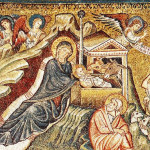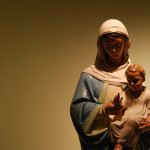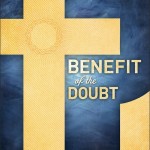We run our website the way we wished the whole internet worked: we provide high quality original content with no ads. We are funded solely by your direct support. Please consider supporting this project.

The Jesus Story is a Myth!…And History
Image by Len dela Cruz
The Jesus story has a curious, and fascinating, relationship with myth and legend.
The story of God coming to earth, being born of a virgin, manifesting a heroic, counter-cultural love toward outcasts, dying for the people who crucified him and then rising from the dead has a familiar “echo” to it. It reconnects us with something we’ve lost along the way, something we’ve perhaps given up on, a dream we’ve forgotten.
Throughout history, and in every culture, people have, in a wide variety of ways, recalled this dream, even without having had any contact with the Jesus story. They’ve expressed this dream through myths and legends. We in modern western culture sometimes respond to unbelievable stories by saying, “Oh, that is just a myth.” “Myth” and “legend” are for most people equivalent to “untrue.” But there is a much more profound sense in which myths and legends can be very true. At their best, myths and legends express our innermost sense of reality, our deepest longings, the obstacles we face in pursuing these longings, and our hope that somehow, someday, these longings will be satisfied. In other words, myths and legends express a dream.
This goes a long way in explaining the curious relationship the Jesus story has with myth and legend. While the Jesus story is unquestionably grounded in history (See The Jesus Legend), it nevertheless bears a certain resemblance to certain myths and legends. The resemblance is due to the fact that this story incarnates in actual history the sense of reality, the longing, the obstacles and the hopes that all great myths and legends express. In Jesus, God shows his love for the world by becoming a human, serving sinners, dying on a cross, rising from the dead, defeating the devil, rescuing humanity and giving them eternal life in fellowship with himself. This is the heart of the Jesus story, and it expresses and addresses a dream that is buried in the depths of the human heart.
While some have tried to use mythic and legendary parallels to argue against the historicity of the Jesus story, these vague mythic and legendary parallels are actually what we should expect if indeed the Jesus story is “true”—in the fullest sense of the term. After all, one aspect of the Jesus story, extending back into the Old Testament, is the teaching that humans are made in the image of God (Gen. 1:26-28). We’re thus “wired” for God, if you will. Not only this, but the New Testament itself declares that Jesus is the light “of all people” (John 1:4, 9) who is always working in the hearts of all people to lead them back to himself (Acts 17:26-28, cf. Rom 1:19-20). We should thus expect to find “echoes” of the Jesus story expressed in the myths and legends of all people.
C.S. Lewis expresses this insight when he writes:
Theology, while saying that a special illumination has been vouchsafed to Christians and (earlier) to Jews, also says that there is some divine illumination vouchsafed to all men… We should, therefore, expect to find in the imagination of the great Pagan teachers and myth makers some glimpse of that theme which we believe to be the very plot of the whole cosmic story—the theme of incarnation, death, and rebirth.
The difference between these myths and legends, on the one hand, and the Jesus story, on the other, is not a “difference between falsehood and truth.” They are both true, but in different senses. As Lewis continues, the difference between them is,
… the difference between a real event on the one hand and dim dreams or premonitions of that same event on the other. It is like watching something come gradually into focus; first it hangs in the clouds of myth and ritual, vast and vague, then it condenses, grows hard and in a sense small, as a historical event in first century Palestine.
This is why Lewis contended that Jesus was “Myth became Fact.” J. R. R. Tolkien, makes the same point when he says,
The Gospels contain a fairy-story … which embraces all the essence of fairy-stories. They contain many marvels—peculiarly artistic, beautiful, and moving: ‘mythical’ in their perfect, self-contained significance; and among the marvels is the greatest and most complete conceivable eucatastrophe [viz. a climatic eruption of joy].
Yet, the story of Jesus in the New Testament isn’t only a fairy-story, according to Tolkien, but a fairy-story incarnated in real time and space. In the person of Jesus, an all-embracing fairy-story “has entered History and the primary world.” Tolkien concludes: [The Christian] story is supreme; and it is true. Art has been verified. God is the Lord, of angels, and of men—and of elves. Legend and History have met and fused.
If we are honest with ourselves, and if we grasp the depth of the “good news” this story embodies, something quite like the Jesus story is what we hope to be true. Yet, most amazingly, this story gives us reason to believe it is historically true.
We have reason, therefore, to conclude that this story is, at the same time, both true myth and true history.
—Adapted from Lord or Legend? Pages 148-151
Category: General
Tags: C.S. Lewis, Gospels, History, J. R. R. Tolkien, Jesus, Legend, Lord or Legend?, Myth, Resurrection, Truth
Topics: Christology
Related Reading

The Cross in the Manger
There has been a strand within the Western theological tradition—one that is especially prevalent in contemporary American Evangelicalism—that construes the significance of the cross in strictly soteriological terms. The cross is central, in this view, but only in the sense that the reason Jesus came to earth was to pay the price for our sin…

Oh Constantine
Once upon a time there was a Roman Emperor named Constantine who used the enemy-loving Jesus to kill his enemies. What does this have to do with us? Find out:

Was Jesus Fully Human and Fully God?
The New Testament is very clear that Jesus was a full human being. He had to grow in wisdom (Lk 2:52) and learn obedience by going through trials, just like every other human being (Heb. 5:8). He grew hungry and tired, like the rest of us. He experienced the same range of emotions as the…

Benefit of the Doubt Is Here!
Benefit of the Doubt is finally here and you should definitely get yourself a copy! Frank Viola interviewed Greg about the book recently and you can read it over on Frank’s blog Beyond Evangelical. In fact, Frank is so enthusiastic about the book that he added it to his Best 100 Christian Books Ever Written list. Wow. Also,…

“Whatever it means, it cannot mean that.”
pure9 via Compfight Roger Olson wrote a great article a couple of days ago entitled Why (High) Calvinism Is Impossible. He points out that there is no way to understand God as “good” while also believing in double predestination. The idea that God predestines some to heaven and a vast majority to hell for his “glory”…

Podcast: Does Historicity of Bible Stories Matter?
Greg discusses his phenomenological-theological approach—or, HOW is the Bible inspired? Primarily through the narrative? Or primarily historically accuracy? http://traffic.libsyn.com/askgregboyd/Episode_0248.mp3
